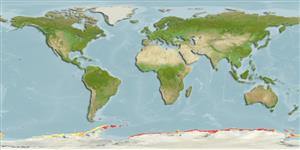>
Perciformes/Notothenioidei (Icefishes) >
Artedidraconidae (Barbled plunderfishes)
Etymology: Pogonophryne: Greek, pogon = beard + Greek, phrynos = toad (Ref. 45335).
Eponymy: Vladimir Viktorovich Barsukov (1922–1989) was a Russian Ichthyologist, who was a Senior Research Scientist at the Zoological Institute of the USSR Academy of Science and Director of its Ichthyology Laboratory for seventeen years. [...] (Ref. 128868), visit book page.
More on author: Andriashev.
Environment: milieu / climate zone / depth range / distribution range
Ökologie
seewasser bathydemersal; tiefenbereich 195 - 1120 m (Ref. 5181). Deep-water; 60°S - 74°S
Southern Ocean: (Knox Coast, Ross Sea, Queen Maud Land), South Shetland Islands and South Orkney Islands.
Size / Gewicht / Alter
Maturity: Lm ? range ? - ? cm
Max length : 25.0 cm TL Männchen/unbestimmt; (Ref. 5181); max. veröff. Gewicht: 199.40 g (Ref. 124149)
Biology unknown (Ref. 5181). Minimum depth from Ref. 58018.
Life cycle and mating behavior
Geschlechtsreife | Fortpflanzung | Ablaichen | Eier | Fecundity | Larven
Eakin, R.R., 1990. Artedidraconidae. p. 332-356. In O. Gon and P.C. Heemstra (eds.) Fishes of the Southern Ocean. J.L.B. Smith Institute of Ichthyology, Grahamstown, South Africa. (Ref. 5181)
IUCN Rote Liste Status (Ref. 130435: Version 2024-1)
Bedrohung für Menschen
Harmless
Nutzung durch Menschen
Fischereien: nicht kommerziell
Tools
Zusatzinformationen
Download XML
Internet Quellen
Estimates based on models
Preferred temperature (Ref.
123201): -1.4 - 1.4, mean 0.5 °C (based on 444 cells).
Phylogenetic diversity index (Ref.
82804): PD
50 = 0.5000 [Uniqueness, from 0.5 = low to 2.0 = high].
Bayesian length-weight: a=0.00631 (0.00362 - 0.01099), b=3.22 (3.06 - 3.38), in cm total length, based on LWR estimates for this species & (Sub)family-body (Ref.
93245).
Trophic level (Ref.
69278): 3.3 ±0.5 se; based on size and trophs of closest relatives
Fishing Vulnerability (Ref.
59153): Low vulnerability (15 of 100).
